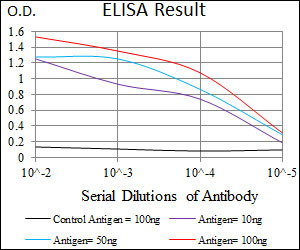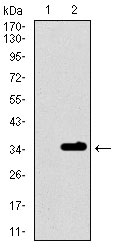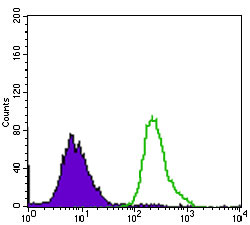P2RY13 Antibody
Purified Mouse Monoclonal Antibody
- 产品详情
- 实验流程
- 背景知识
Application
| WB, FC, E |
|---|---|
| Primary Accession | Q9BPV8 |
| Reactivity | Human |
| Host | Mouse |
| Clonality | Monoclonal |
| Clone Names | 2H1G9 |
| Isotype | IgG1 |
| Calculated MW | 40789 Da |
| Description | The product of this gene belongs to the family of G-protein coupled receptors. This family has several receptor subtypes with different pharmacological selectivity, which overlaps in some cases, for various adenosine and uridine nucleotides. This receptor is activated by ADP. |
| Immunogen | Purified recombinant fragment of human P2RY13 (AA: 1–49) expressed in E. Coli. |
| Formulation | Ascitic fluid containing 0.03% sodium azide. |
| Gene ID | 53829 |
|---|---|
| Other Names | P2Y purinoceptor 13, P2Y13, G-protein coupled receptor 86, G-protein coupled receptor 94, P2RY13, GPR86, GPR94 |
| Dilution | WB~~1/500 - 1/2000 FC~~1/200 - 1/400 E~~1/10000 |
| Storage | Maintain refrigerated at 2-8°C for up to 6 months. For long term storage store at -20°C in small aliquots to prevent freeze-thaw cycles. |
| Precautions | P2RY13 Antibody is for research use only and not for use in diagnostic or therapeutic procedures. |
| Name | P2RY13 |
|---|---|
| Synonyms | GPR86, GPR94 |
| Function | Receptor for ADP. Coupled to G(i)-proteins. May play a role in hematopoiesis and the immune system. |
| Cellular Location | Cell membrane; Multi-pass membrane protein. |
| Tissue Location | Strong expression in spleen and adult brain. Lower expression in placenta, lung, liver, spinal cord, thymus, small intestine, uterus, stomach, testis, fetal brain, and adrenal gland. Not detected in pancreas, heart, kidney, skeletal muscle, ovary or fetal aorta. Clearly detected in lymph node and bone marrow, weakly detected in peripheral blood mononuclear cells (PBMC) and in peripheral blood leukocytes (PBL), but not detected in polymorphonuclear cells (PMN). In the brain, detected in all brain regions examined |
For Research Use Only. Not For Use In Diagnostic Procedures.
Provided below are standard protocols that you may find useful for product applications.
BACKGROUND
Cell adhesion molecules (CAMs) are members of the immunoglobulin superfamily. This gene encodes a neuronal cell adhesion molecule with multiple immunoglobulin-like C2-type domains and fibronectin type-III domains. This ankyrin-binding protein is involved in neuron-neuron adhesion and promotes directional signaling during axonal cone growth. This gene is also expressed in non-neural tissues and may play a general role in cell-cell communication via signaling from its intracellular domain to the actin cytoskeleton during directional cell migration. Allelic variants of this gene have been associated with autism and addiction vulnerability. Alternative splicing results in multiple transcript variants encoding different isoforms. ;
REFERENCES
1. J Pharmacol Exp Ther. 2002 May;301(2):705-13.2. Mol Biotechnol. 2008 Jul;39(3):239-64.
终于等到您。ABCEPTA(百远生物)抗体产品。
点击下方“我要评价 ”按钮提交您的反馈信息,您的反馈和评价是我们最宝贵的财富之一,
我们将在1-3个工作日内处理您的反馈信息。
如有疑问,联系:0512-88856768 tech-china@abcepta.com.























 癌症的基本特征包括细胞增殖、血管生成、迁移、凋亡逃避机制和细胞永生等。找到癌症发生过程中这些通路的关键标记物和对应的抗体用于检测至关重要。
癌症的基本特征包括细胞增殖、血管生成、迁移、凋亡逃避机制和细胞永生等。找到癌症发生过程中这些通路的关键标记物和对应的抗体用于检测至关重要。 为您推荐一个泛素化位点预测神器——泛素化分析工具,可以为您的蛋白的泛素化位点作出预测和评分。
为您推荐一个泛素化位点预测神器——泛素化分析工具,可以为您的蛋白的泛素化位点作出预测和评分。 细胞自噬受体图形绘图工具为你的蛋白的细胞受体结合位点作出预测和评分,识别结合到自噬通路中的蛋白是非常重要的,便于让我们理解自噬在正常生理、病理过程中的作用,如发育、细胞分化、神经退化性疾病、压力条件下、感染和癌症。
细胞自噬受体图形绘图工具为你的蛋白的细胞受体结合位点作出预测和评分,识别结合到自噬通路中的蛋白是非常重要的,便于让我们理解自噬在正常生理、病理过程中的作用,如发育、细胞分化、神经退化性疾病、压力条件下、感染和癌症。









